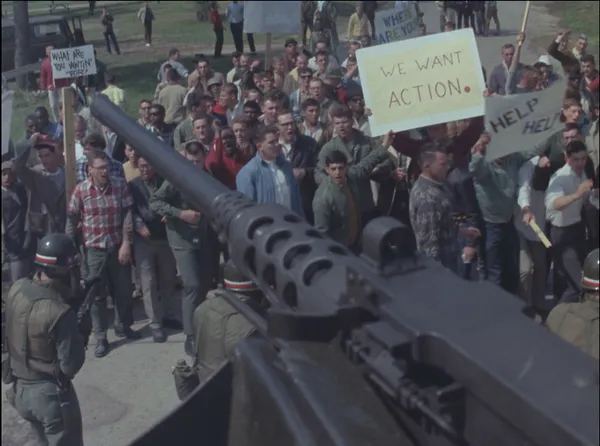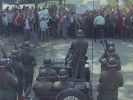Eye For Film >> Movies >> Riotsville, USA (2022) Film Review
Riotsville, USA
Reviewed by: Jeremy Mathews

At first glance it looks quaint, like a movie lot’s set for a generic American Main Street. But there’s something a bit deeper — in some ways sinister, in others desperate — to the subject of Sierra Pettengill’s Riotsville, USA. The documentary shows us a series of hollow facades that the US government built during the social upheaval of the late 1960s, when persecuted black populations and anti-war protesters began to rebel against the status quo.
The government built multiple fake towns to train law enforcement from across the nation how to squash riots. These “Riotvilles” turn out to be a great visual metaphor for the government response to social unrest as a whole: one-dimensional towns trying to solve multi-dimensional problems.

Director Sierra Pettengill constructs the documentary entirely from archival footage. Any interviews or focus groups are from the period (though we are told that none of the people who worked at Riotsville relayed any strong memories of it when contacted in the modern day).
That’s not to say the work is without an agenda or historical perspective. It features voiceover commentary on the training courses as well as other endeavors President Lyndon B Johnson’s administration took to restore a sense of control and normality. The structure moves in and out of different themes, with Riotsville as the recurring motif. One of the most interesting segments follows the formation of the Kerner Commission, which Johnson appointed to investigate the cause of the riots, only to find socially forward recommendations that were expensive and politically unpopular.
While Pettengill is fascinated by the archival content, she’s also not afraid to experiment with form, including digital distortions that identify the movie as a product of the present. A slow-motion shot of role-playing rioters reveals itself to be an AI-interpolation pulled from real time footage. You can tell because the algorithm can’t figure out what to do with motion-blur from the subjects’ arms, causing them to disappear or turn into a surreal blur of confused pixels. In another sequence, details of printed text pile up onto each other, eventually erupting into an orgy of digital chaos.
These anachronistic effects serve as reminder that all media we consume is in some way a distortion of the source material. However, they feel rather tangential to the main thesis. By contrast, another sequence in which close-ups from magazine photos slowly morph into different, barely discernible details feels more at home as it meditates on the elusive disappearance of certain figures and ideas from the past.
The final section of the film focuses on the protests and riots surrounding the 1968 Republican National Convention in Miami Beach, Florida. The footage persuasively makes the point that while the unrest surrounding the Democratic convention in Chicago became a historic and cultural milestone, the Republican Convention provides a better illustration of how US society typically treats voices of dissent: by pushing them out of sight and discrediting their leaders. Driving the point home, we see the TV coverage of the convention repeatedly cut to absurd ads for sponsor Gulf Oil.
During its closing moments, there’s a sense that the movie wants to impart a certain importance of the Riotsville training courses, as if the lessons taught there are largely responsible for the subsiding of the riots. This may be true, but Riotsville, USA doesn’t quite build a rock-solid case. From what we see, it seems just as likely that Riotsville was simply another symptom of the nation’s paranoia — the failings of a government that was scrambling for any solution to social unrest.
Regardless, it remains a fascinating artifact of the time, and an effective jumping-off point to explore a period that has many parallels with modern times.
Reviewed on: 22 Jan 2022

















